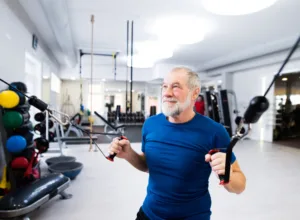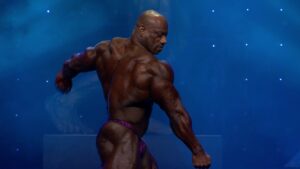Aging is associated with a progressive decline of muscle mass, strength, and quality, a condition described as sarcopenia of aging. Despite the significance of skeletal muscle atrophy, the mechanisms responsible for the deterioration of muscle performance are only partially understood. The purpose of this review is to highlight cellular, molecular, and biochemical changes that contribute to age-related muscle weakness.
Researchers have explored numerous contributors to the loss of muscle strength with age, and it appears to boil down to two major factors: muscle quality and neuromuscular innervation.
I’ve spoken at length on the importance of muscle strength as a determining factor for healthy longevity. Unfortunately, muscle mass and strength naturally decrease as we age, but why? And is there anything we can do about it?
To illustrate the extent of age-related muscle loss, I’ve collected data from two studies of the many studies on this topic and have calculated the general percentage of muscle loss per decade after our 30s (Table 1). “Loss of both muscle mass and muscle strength accelerates as we age, though the rate of muscle strength loss is typically far greater than the rate of muscle mass loss. Although muscle mass does affect muscle strength, these data suggest that there may be something else at play to explain age-related strength loss”.
Related Articles: The “5 Mistakes” Most Young Bodybuilders Make When Trying “To Build Muscle And Physical Strength”
| Table 1. Change in muscle mass and strength by decade | ||
| Age | Muscle mass of men, whole-body lean mass % change per decade |
Muscle strength of men, grip strength % change per decade |
| 40-49 | +1.9 | -3.1 |
| 50-59 | -0.7 | -3.6 |
| 60-69 | -4.2 | -9.2 |
| 70-79 | -7.2 | -11.7 |
Why Do Muscles Lose Strength As We Get Older?
Normally, skeletal muscle produces contractile force based on a complex, coordinated series of events. Muscles are innervated by motor neurons originating from the brain or spinal cord, which provide the signal for muscle contraction. An impulse from a motor neuron reaches the muscle through the neuromuscular junction, after which the excitatory signal propagates through the muscle fiber. This impulse triggers the release of calcium in the muscle fiber, which induces interactions between two key proteins – myosin and actin – and this interaction, which depends on the energy in the form of ATP, is what ultimately results in muscle contraction.
Researchers have explored numerous systemic, cellular, and molecular systems to determine why we experience a loss of muscle strength with age, and it appears to boil down to two major factors: muscle quality and neuromuscular innervation.
Loss Of Muscle Quality
Unfortunately, the loss of muscle quality is inevitable, progressing intrinsically at the cellular level at multiple steps along the muscle contraction pathway. For instance, in older muscles, the excitation-contraction coupling becomes inefficient due to a decline in the number of calcium ion channels in the muscle fiber. Age is also associated with myosin structural changes that reduce its ability to remain in a strong-binding, force-generating state, so muscle contraction is weaker. Additionally, we accumulate oxidative stress-related DNA damage as we age, resulting in a decline in muscle mitochondrial function and lower mitochondrial density, ultimately leading to insufficient production of the ATP needed for muscle contraction.
Another unavoidable factor contributing to age-related muscle quality decline is a change in the distribution of type I “slow-twitch” and type II “fast-twitch” fibers that make up the muscle. As you may recall from my first podcast interview with a Personal trainer and Strength coach, Bigflex Dogg, type I fibers, which are slower to contract and more resistant to fatigue, are used during low-intensity endurance activities but aren’t useful for fast, powerful movements. In contrast, type II fibers contract much faster and with greater force to produce high-tension output. These are the powerful muscles that facilitate explosive movements like sprinting and jumping. As we age, the proportion of type II fibers decreases, resulting in reduced muscle strength.
Related Articles: Follow These “Strength And Muscle-Building Laws” For Dope And Effective Results
Check Out Our List Of The Best Supplements For Building Muscle, Shredding Muscle, Recovery, And Great Health, and Wellness Products! Purchase ifbnewsfeed.org‘s apparels Here: ifbnewsfeed.org
 Loss of Innervation
Loss of Innervation
In addition to the loss of muscle quality, another major factor contributing to muscle strength decline is the loss of neuromuscular innervation. Throughout one’s life, nerves constantly undergo cycles of innervating and denervating muscle fibers depending upon muscle usage. “Muscles that experience high use through repetitive movements or greater tension have more nerve-muscle connections to support muscle activation. The more a muscle is used, the more neuromotor connections it develops, which leads to improved contractile strength”. The opposite is also true: muscles that are seldom used become less innervated. Prolonged denervation leads to reduced function and deterioration of neuromuscular communication.
In healthy young individuals, there is typically a balance between innervation and denervation of muscles (processes collectively called “remodeling”) in response to usage. However, in older populations, denervation appears to outpace reinnervation, independent of activity level. Studies suggest this may be due to unstable neuromuscular junctions, motor neuron death that occurs with aging, and the impaired ability of neurons to reinnervate fibers. The reduced density of neural connections to muscle fibers equates to reduced communication between the brain and muscle, resulting in lower force, lower speed, and overall compromised performance.
What Can We Do About It?
“Although little can be done to mitigate the age-related decline in muscle quality, we do have some control over neuromuscular remodeling. Increased activation of muscle fibers through physical activity initiates a cascade of events that attenuate muscle strength loss. Active muscle releases a number of biochemical signals which promote the growth of motor neuron fibers, induce them to form more connections to the muscle, and enhance excitatory signal transmission at the neuromuscular junction”. These combined effects improve neuromuscular communication and lead to better control and increased strength of muscle contractions, counteracting the effects of aging muscles. In particular, endurance and power training appear to contribute significantly to neuromuscular remodeling, and data from life-long athletes indicate that regular exercise in our later years is effective in improving muscle strength and function.
Now all of this information brings me to a simple conclusion – one which I’ve stated time and again: keep exercising throughout life. It is unequivocally the very best weapon in our arsenal when it comes to fending off a deterioration in health and extending lifespan. Improved neuromuscular communication is just one more example of the many mechanisms by which exercise counteracts or slows the physiological declines associated with the aging process. So perhaps I’m not saying anything you haven’t heard me say a thousand times before, but the message is so critical that it bears repeating over and over again. Maybe, on your 100th birthday, you’ll be glad I did.
Related Articles:
- People Lose “30% Of Their Muscle Strength” Between The Ages Of 50 And 70 years
- The “5 Best Bodyweight Exercises” To Build Muscle, Build Strength, Build Stability And Stay Stronger

- Hormone Replacement Therapy regimen For Men and women
- Hormone Blood Testing for Men (Bodybuilder Blood Testing)
- Shop Optimum Nutrition Energy: Anytime & Pre-Workout
For More News And Daily Updates, Follow IFBNewsfeed.Org on Facebook, Twitter, and Instagram. Comment, Like, And Share With Everyone Who May Need To Be Updated With The Most Recent Fitness/Bodybuilding/Powerlifting And CrossFit News.






